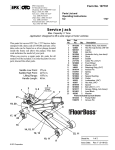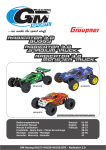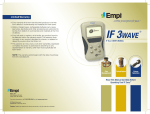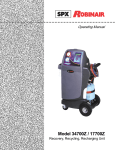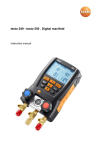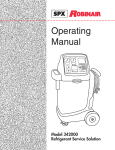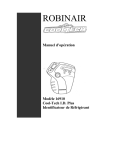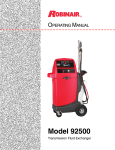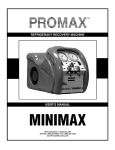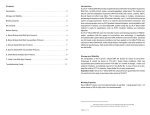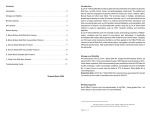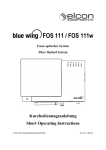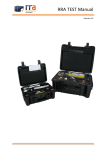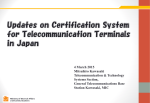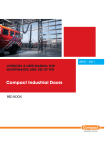Download User Manual
Transcript
Operating Manual Model 16910 ID Plus Refrigerant Identifier Table of Contents Safety Precautions ��������������������������������������������������������������������������2 Unit Description��������������������������������������������������������������������������������4 Hardware Descriptions ��������������������������������������������������������������������7 Operating Procedures��������������������������������������������������������������������10 Error Codes������������������������������������������������������������������������������������18 Maintenance ����������������������������������������������������������������������������������20 Replacement Parts ������������������������������������������������������������������������22 Specifications ��������������������������������������������������������������������������������23 Warranty ����������������������������������������������������������������������������������������24 1 Safety Precautions WARNING : To prevent personal injury: • Study, understand, and follow all warnings in this manual before operating this unit. If the operator cannot read these instructions, operating instructions and safety precautions must be read and discussed in the operator’s native language. —Si el operador no puede leer las instrucciones, las instrucciones de operación y las precauciones de seguridad deberán leerse y comentarse en el idioma nativo del operador. —Si l’utilisateur ne peut lire les instructions, les instructions et les consignes de sécurité doivent lui être expliquées dans sa langue maternelle. • The Identifier gives an alarm (audible and visual) should a sample be determined to be potentially flammable. • Operate this unit with either R-12 or R-134a refrigerant. Cross-contamination with other refrigerant types causes severe damage to the A/C system, to service tools, and equipment. Do NOT attempt to adapt the unit for another refrigerant. Do NOT mix refrigerant types through a system or in the same container. • DO NOT breathe refrigerant and lubricant vapor or mist. Exposure may irritate eyes, nose, and throat. If accidental system discharge occurs, immediately ventilate the work area. There must be adequate ventilation in the vehicle servicing area. • When testing vehicle air conditioning systems, the vehicle ignition and compressor must be turned OFF. This action prevents EMI/RFI problems as well as eliminates potential user hazards from moving parts of the vehicle. • The air detection sensor is a chemical fuel cell sensor that will eventually expire. The user must replace the air detection sensor whenever the instrument indicates as such. Failure to replace the air detection sensor will result in nonfunctionality of the instrument. • Wear eye and skin protection when working with refrigerants. Escaping refrigerant vapors can freeze upon contact. Do NOT direct refrigerant escaping from the sample hose toward exposed skin or toward the face. • To reduce the risk of electrical shock, do not open the instrument housing. Do not use the instrument in wet or damp areas. Minimize the use of extension cords. 2 Safety Precautions Caution : To prevent equipment damage, • Air Detection Warm-Up: For best accuracy in air detection only, allow the instrument an additional 5-minute warm-up period after completion of the warm-up and calibration modes. Allow the instrument to sit undisturbed for 5 minutes following the completion of the initial calibration mode. • Refrigerant Blend: As of December, 1996, there are nine (9) EPA SNAP “acceptable for use” refrigerants that are available and legal for use as R-12 substitutes. The Identifier does not identify any of the substitutes as pure R-12 or pure R-134a. Each of the nine blends has been tested in the factory laboratory and none are able to “fool” the Identifier. Should one of the blends be encountered, the Identifier fails the refrigerant and provides an analysis in terms of percentage by weight concentrations of only R-12, R-134a, R-22, and hydrocarbons. Due to cross-sensitivity issues of the blends on the sensing device, the resultant reading will not be correct in the analyzed concentrations. However, the Identifier never identifies any of the blends as pure R-12 or R-134a. • Sample Filter: Replace the sample filter on the instrument AS SOON AS RED SPOTS OR DISCOLORATION APPEAR ON THE OUTSIDE DIAMETER OF THE WHITE ELEMENT. Failure to correctly maintain and replace the sample filter will result in severe damage to the unit. • Sample Input: The instrument requires connection of the supplied sample hose to the LOW-SIDE or VAPOR port of refrigerant storage cylinders or vehicle air conditioning systems. Do NOT attempt to introduce liquid or samples that are heavily laden with oil into the instrument. Do NOT connect the sample hose to the HIGH-SIDE or LIQUID PORT. Liquid or oil laden samples cause severe damage to the instrument. ALWAYS verify the refrigerant to be tested does not contain or will not emit heavy loads of oil or liquid. • Air Purge: Do NOT attempt to purge the detected air from refrigerant sources that are vapor only. In order to purge air from refrigerant sources, there MUST be some quantity of liquid refrigerant present to replace the volume of the air. Attempts to purge the air from vapor-only sources will result in the loss of the entire refrigerant charge. • Inspect the sample hose before each use. Replace the hose if it appears cracked, frayed, obstructed, or fouled with oil. Do NOT use hoses other than those supplied with the instrument. The use of other hose types will introduce errors into the refrigerant analysis and instrument calibration. • Do NOT open the instrument housing. There are no serviceable components internal to the instrument, and opening the housing will void the warranty. • Place the Identifier on a flat and/or sturdy surface or utilize the housing hanging hook. • NEVER admit any sample into the instrument at pressures in excess of 300 psig. • Do not use the coupler supplied on the service end of the R-134a sample hose for any application other than with the instrument. The coupler is modified, does not contain a check valve, and is not suitable for any other refrigerant application. • Never obstruct the air intake, sample exhaust, or vent ports of the instrument during use. 3 Unit Description Contamination of refrigerants either in storage cylinders or vehicle air conditioning systems can lead to component corrosion, elevated head pressures, and system failures when used by unsuspecting technicians. The ability of the technician to determine refrigerant type and purity is severely hampered by the presence of air when attempting to use temperature-pressure relationships. The development of various substitute refrigerants further complicates the ability of technicians to determine refrigerant purity based upon temperature-pressure relationships. The substitute refrigerant blends can also introduce a flammability hazard to the refrigerant technician and the ultimate end-user of the vehicle air conditioning system. Non-condensable gasses (NCG), which are mainly comprised of ambient air, commonly contaminate refrigerant stores or systems. Contamination can be introduced into refrigerant from sources such as leaking joints on vehicle air conditioning systems, incorrect handling of transfer hoses, incorrect use of refrigerant recovery and recycling equipment, or failure of such equipment. Ambient air contamination will lead to a number of refrigerant system problems, including corrosion induced by moisture content of the ambient air, increased compressor heat and wear due to increased head pressures, added stress on system components due to increased head pressures, and reduction of system efficiency due to displacement of refrigerant by the ambient air or NCG. The identifier provides a fast, easy, and accurate means to determine refrigerant purity in refrigerant storage cylinders or directly in vehicle air conditioning systems. It also determines the need and controls the purging of ambient air-based NCG from refrigerant storage vessels or vehicle air conditioning systems. The instrument uses non-dispersive infrared (NDIR) technology to determine the weight concentrations of refrigerant types R-12, R-134a, R-22, hydrocarbons, and air. Refrigerant purity is automatically determined for refrigerants R-12 and R-134a by the instrument to eliminate human error. Pure refrigerant is defined as a refrigerant mixture that contains 98% by weight, or greater, of either R-12 or R-134a. 4 Unit Description The instrument provides the option to purge sample refrigerant sources of air contamination down to levels set by the user. Air purging is completely automatic and requires no intervention by the user other than telling the instrument to begin the purging process. The instrument is supplied complete with R-12 and R-134a sample hoses, an R-134a adapter fitting to permit sampling of ACME-ported cylinders, a purge vent hose, a power cord, and all required plumbing housed within a rugged portable case. Refrigerant Identification Sample gas is admitted into the instrument through the supplied sample hose and is presented to the sensing device. The instrument provides the user with direct percent-by-weight concentrations of R-12, R-134a, R-22, and hydrocarbons. If the sample is determined to be pure R-12 or pure R-134a, the instrument also provides a direct readout of the weight percentage of air within the sample. Note that the instrument does not consider air to be a contaminate, since it can be removed by refrigerant recycling equipment or by the purging feature of the instrument itself. Since air is not considered a contaminate, it is possible to read 100% R-12 plus 5% air. The instrument only considers the weights of refrigerant contaminates in the total mixture. The instrument interfaces with the user through the use of a 2-line, 16-character, alphanumeric display, status indicator lamps, pushbutton communication switches, and an alarm. Alarm indications are provided to alert the user of instrument fault conditions, potentially flammable refrigerant presence, and contaminated refrigerant presence. Direct percent-by-weight concentrations of sample refrigerant are provided on the display, as well as user directions and prompts. A printer port is supplied with the instrument that interfaces with most parallel port printers. 5 Unit Description Air-Radicator Purging When a refrigerant source has been determined to be pure (at least 98% by weight of either R-12 or R-134a), the instrument automatically offers the air purging feature to the user, should there be any air contamination. Continuous monitoring of the venting gas stream to determine exact air concentrations controls the purging feature. Purging limits can be set by the user between 2%–9% by weight to tailor the purge to specific needs. The instrument controls all functions of the purging feature with no intervention by the user required to complete the procedure. The user can halt or cancel this procedure at any time. Control of the purge operation is achieved through direct measurements of refrigerant concentration and is not dependent upon temperature or pressure measurements. Existing technology in the vehicle air conditioning market typically uses both pressure and temperature measurements to determine air concentration and to control the purging procedure. Pressure-temperature technology is susceptible to errors induced by refrigerant contamination and difficulties in obtaining precise temperature and pressure measurements. This is due to the inability to account for rapid temperature and pressure drops of the refrigerant during the purge procedure by temperature-pressure based equipment or procedures. Temperature-pressure based technology commonly requires the refrigerant source to come to a temperature-pressure equilibrium before purging can begin. This process can take as long as eight to 24 hours. With direct measurement of refrigerant concentrations, there is no need to wait for a refrigerant source to reach a temperature and pressure equilibrium. Also, rapid temperature and pressure changes during purging operations do not affect the measurements. 6 Hardware Descriptions The Identifier provides the user with a complete tool to identify refrigerant mixtures, and rid the mixtures of air contamination, all housed in a portable, rugged carrying case. Housing The instrument is housed in a rugged, hand-held, injection-molded nylon case. The case houses the sensing devices, the plumbing system, and the electronics of the instrument. Power Cord A nine-foot (2.75 meter), molded, three-prong, grounded, NEMA, power supply cord is attached directly to the instrument. Different power cords may be supplied if the instrument is to be used in areas outside North America. Sample Filter The sample filter provides retention of particulate and oil mist suspended within the sample vapor. The filter is supplied with a red, maintenance-indicating dye. As soon as red spots or discoloration begin to appear anywhere on the white outside diameter of the filter element, THE FILTER MUST BE REPLACED. Failure to replace the filter when indicated may lead to severe instrument damage not covered under warranty repairs. Air Intake Port The air intake port is located at the top of the instrument and provides the entry point for ambient air into the instrument during calibration procedures. Never obstruct the port during use of the instrument. Sample Exhaust Port The sample exhaust port, located on the bottom edge of the instrument, will emit spent sample gasses. Keep this port clear and unobstructed during use. Sample Inlet Port The sample inlet port admits refrigerant vapor into the instrument through the connection of the mating end of the sample hose. System Pressure Gauge The system pressure gauge indicates to the user the presence of a refrigerant sample flow into the instrument. 7 Hardware Descriptions Purge Vent Port The purge vent port emits a mixture of refrigerant vapor and air during purging procedures. The port is supplied with a protective cap that must be replaced with the purge vent hose during purging operations. The cap must remain installed on the port during refrigerant identification procedures to avoid excessive losses of refrigerant. WARNING Failure to correctly install the cap onto the purge vent port will result in excessive loss of refrigerant during the refrigerant identification procedure, which is a health hazard. The instrument ALWAYS performs a refrigerant identification before permitting an air purge procedure. Printer Port The printer port is a 25-pin connector used to download results of sample analysis to a usersupplied printer through a user-supplied cable. The port supports most parallel port printers. R-12 Sample Hose The 6-foot (1.8 meter) R-12 sample hose is constructed of a nylon inner tube and a polyurethane outer tube. The inner tube handles all refrigerant transfer and provides containment up to 300 psig. The outer tube provides protection of the inner tube from abrasion, nicking, cutting, etc. The hose is provided with an instrument inlet port mating connector on one end and a 1/4 in. SAE internal flare coupling. R-134a Sample Hose The 6-foot R-134a sample hose is constructed of a nylon inner tube and a polyurethane outer tube. The inner tube handles all refrigerant transfer and provides containment up to 300 psig. The outer tube provides protection of the inner tube from abrasion, nicking, cutting, etc. The hose is provided with an instrument inlet port mating connector on one end and an R-134a low-side coupler on the service end. 8 Hardware Descriptions Purge Vent Hose The purge vent hose is a 6-foot length of neoprene tubing with a connector on one end to mate with the purge vent port. The hose is used to direct venting refrigerant vapor and air contamination away from the instrument and the ambient air inlet port. This process ensures no calibration errors or faults occur during purging procedures. R-134a Tank Adapter Fitting The R-134a tank adapter fitting provides the user with an adapter to allow connection of the R-134a sample hose service end to an R-134a cylinder ACME port. Control Panel The control panel contains all the user interfaces to permit operation of the instrument: Digital Display A 2-line, 16-character, alphanumeric display is provided to inform the user of system status, required actions, and prompts for specific inputs. Pushbutton Switches Two switches, labeled “A” and “B”, are provided for various functions. All inputs from the user to the instrument are made using these switches. Use of the switches is detailed on the instrument display. LED Status Indicator Lamps Red and green LEDs are provided to inform the user of system status at a glance or to alert the user of required actions or conditions. The LEDs serve dual functions, depending upon the instrument function: • During refrigerant identification functions, as indicated by the IDENTIFIER FUNCTION on the LED label, the green LED indicates refrigerant purity. The red LED indicates refrigerant contamination or system faults. • During air purging functions, as indicated by the AIR RADICATOR FUNCTION on the LED label, the green LED indicates purge completion, and the red LED indicates system fault. Storage Case The instrument is supplied with a portable, corrugated, storage case. The case houses the instrument, the operating manual, and all associated accessories. 9 Operating Procedures Pre-Operation Procedure 1.Inspect the sample filter for signs of red spots or discoloration anywhere on the white outside diameter of the filter element. If any red spots or discoloration are noticed, REPLACE THE FILTER BEFORE USING THE INSTRUMENT. CAUTION When red spots or discoloration begin to appear on the white outside diameter of the filter element, REPLACE THE FILTER. Failure to correctly maintain the sample filter may result in severe instrument damage not covered under warranty. 2.Select the R-12 or R-134a sample hose according to the application. Inspect the hose for signs of wear, such as cracking, fraying, or kinks. Verify the hose is not obstructed and no oil is present inside the hose. If the hose shows signs of wear, obstructions, or oil, IT MUST BE REPLACED (or cleaned) BEFORE USING THE INSTRUMENT. 3.Install the sample hose onto the inlet port of the instrument. The hose connector needs only to be fingertight to achieve a gas-tight seal. 4.Inspect the air intake port, the sample exhaust port, and the case vent ports of the instrument to verify they are clear and unobstructed. 5.Verify the purge vent port cap is securely installed onto the port. WARNING Failure to correctly install the cap onto the purge vent port results in excessive loss of refrigerant during the refrigerant identification procedure, which is a health hazard. A refrigerant identification is ALWAYS performed before an air purge procedure. 6.Inspect the sample port of the refrigerant storage cylinder or vehicle air conditioning system to be tested. Verify the port is the LOW SIDE or VAPOR port. 10 Operating Procedures Refrigerant Identification Operational Procedure 1.Plug the power cord of the instrument into a suitable receptacle. Various parameters of the instrument are displayed and the warm-up period begins. 2.The warm-up period lasts for 90 seconds. The display reads SYSTEM WARMING– CHECK FILTER, which is a reminder to inspect the instrument's sample filter. 3.During the warm-up period, it is possible to print the results of the last refrigerant identification run made prior to power-up of the instrument. To print the prior results, connect a user-supplied cable and printer to the instrument printer port, and press the “A” button. The prior results are downloaded to the printer. 4.During the warm-up period, enter the local elevation above sea level into the instrument memory. The instrument is sensitive to elevation changes of 500 feet (152 meters), and the local elevation must be entered into the instrument memory upon initial use. After the local elevation has been entered into the instrument memory, there is no need to enter it again unless the instrument is moved to a new elevation. To enter the elevation into the instrument memory, follow the procedure presented by the instrument display. A.During the warm-up period, depress and hold the “A” and “B” buttons simultaneously until the display reads USAGE ELEVATION, 400 FEET. This is the factory setting of 400 ft. (122 meters) elevation. B.Use the “A” and “B” buttons to adjust the elevation to the nearest 100-foot (30-meter) increment. Pushing the “A” button increases the elevation setting by 100-ft. increments. Pressing the “B” button decreases the elevation setting by 100-ft. increments. The setting is adjustable from 0–9000 feet (0–2743 meters) and is displayed while adjusting. 11 Operating Procedures C.When the correct setting of local elevation has been achieved, allow the instrument to sit for 20 seconds while not pushing either of the buttons. The instrument automatically returns to the warm-up period, and the elevation setting is stored in memory. 5.After completion of the warm-up period, the instrument self-calibrates. Ambient air is drawn in through the air intake port and is presented to the sensing device for calibration. The calibration period runs for 20 seconds. 6.When the calibration period is completed, the instrument displays READY: CON. HOSE, PRESS A TO START, and the green LED flashes. Connect the service end of the sample hose to the low side or vapor port of the refrigerant storage vessel or vehicle air conditioning system to be sampled. When the hose is secured into position, press the “A” button of the instrument to start processing. NOTE: For correct operation, the instrument pressure gauge should read at least 10 psig. Tech Tip: To achieve the best air detection accuracy, allow the instrument to warm up an additional 5 minutes before pressing the “A” button as stated in Step 5. This allows additional warming and stabilization of the sensing device before sampling. During the additional warm-up period, the instrument will “Time-Out” and display RECAL. Disconnect the sample hose from the refrigerant source, and press the “A” button to re-calibrate. Once re-calibration is complete, it is not necessary to repeat additional warm-up periods as long as the instrument is not powered down between sample runs. 7.The instrument reads SAMPLING IN PROGRESS while a small refrigerant sample is analyzed to determine the concentrations of R-12, R-134a, R-22, hydrocarbons, and air. Once analysis is complete, the percentage of concentrations of R-12, R-134a, R-22, and hydrocarbons is displayed. Press “A” to print the results, press “B” to exit (if there is no air), or press “B” to continue the purge function if air is present. 12 Operating Procedures 8.The instrument presents the results of the analysis as outlined below: PASS R-134a: If the instrument has detected 98% by weight or greater concentration of R-134a, the green PASS LED illuminates and the weight concentrations of R-12, R-134a, R-22, hydrocarbons, and air are displayed. The display then prompts the user to press “A” to print, or press “B” to continue. See Step 9. PASS R-12: If the instrument has detected 98% by weight or greater concentration of R-12, the green PASS LED illuminates and the weight concentrations of R-12, R-134a, R-22, hydrocarbons, and air are displayed. The display then prompts the user to press “A” to print, or press “B” to continue. See Step 9. Refrigerant FAIL: If the weight concentration of either R-12 or R-134a is not at least 98%, the instrument will sound the alarm horn five times. The red FAIL LED illuminates and the weight percentages of R-12, R-134a, R-22, and hydrocarbons are displayed. Note the instrument does not permit purging procedures on contaminated mixtures. The display prompts you to press “A” to print, or press “B” to exit. Tech Tip: We suggest retesting a refrigerant source whenever a refrigerant FAIL occurs to provide verification of initial results. Hydrocarbon Alarm: If hydrocarbon concentrations are sensed to be 2% by weight or greater, the instrument sounds the alarm horn 30 times, illuminates the red FAIL LED, displays HYDROCARBONS HIGH, and displays the weight concentrations of R-12, R-134a, R-22, and hydrocarbons. The display then prompts the user to press “A” to print, or press “B” to exit. WARNING The occurrence of the hydrocarbon alarm alerts you to the presence of potentially flammable refrigerant mixtures. YOU BEAR FULL RESPONSIBILITY for the removal of the potentially hazardous mixture from the instrument and any other attached equipment. 13 Operating Procedures 9. You may now print the results of the analysis. Connect a user-supplied cable and parallel printer to the printer port of the instrument. Turn on the printer, and press the “A” button of the instrument. The results of the last analysis are downloaded to the printer. Note: Should a printer not be readily available, the instrument stores the LAST result only for printout during the next warm-up period, as described in Step 3. If no printout is desired, press the “B” button. In the case of pure refrigerant, the instrument reverts to the purge procedure should there be greater than 2% by weight air concentrations. The instrument prompts you if an air purge is desired as described in the Air Purge Operation Procedure. The instrument returns to a calibration mode when the “B” button is pressed for refrigerants detected to be pure and have 2% or less air contamination, or refrigerants detected to be contaminated. Air Purging Operation Procedure WARNING Because leaks can develop in the sample hose connections or the refrigerant source, causing a health hazard, do NOT allow the purging feature to operate for extended periods, such as overnight, without periodic inspection of the sample hose connections for leaks. 1.Whenever the instrument has determined that a refrigerant source is pure (98% by weight or greater R-12 or R-134a), and the air concentration levels exceed 2%, you are prompted if an air purge is desired. Press the “A” button to initiate the purge procedure, or press the “B” button to cancel the purge procedure. 2.After the instrument is instructed to purge, the user has the option to adjust the purge limit setting by pressing the “B” button. The purge limit setting is the level to which the air is reduced by the instrument. The limit is adjustable by 0.1% increments from 2%–9%. To set the limit, press the “A” button to raise the limit or the “B” button to lower the limit. When the desired setting is reached and is displayed, allow the instrument to sit for 15 seconds without pressing any of the buttons. The instrument automatically stores the setting and continues with the procedure. 14 Operating Procedures 3.The instrument reads REMOVE PURGE CAP, CON. HOSE, PRS A. This message instructs you to remove the cap installed on the purge vent port, and replace it with the purge vent hose. Direct the free end of the hose away from the instrument so escaping gasses are not directed back towards the instrument. When the hose is securely connected, press the “A” button to continue. 4.The instrument reads NOW AIR IS XX.X% PURGING TO XX%. This message indicates the purging procedure has begun and displays the purge limit setting. NOTE: The purging procedure may be halted or cancelled at any time by pressing and holding either the “A” or “B” buttons during the procedure. When either button is pressed and held, the instrument displays PURGE STOPPED, PRESS A TO CONT. B TO EXIT. To end the purge process, press the “B” button. To continue with the purge procedure, press the “A” button. In either case, the instrument performs a self-calibration and either continues with the purge procedure or prompts you for another run. If the purge process has been stopped, and “B” was selected (exit purge process), you must replace the cap on the purge port and disconnect the service end of the sample hose. Not Pure Alarm: If the instrument detects that the level of R-12 or R-134a is not at least 98% by weight, an alarm sounds and the purging process is halted. If the alarm sounds, press “B” to continue. The purge procedure is cancelled, and the instrument reverts to self-calibration, ready for a new procedure. Excessive Air Alarm: If air contamination is detected to be 25% by weight or greater, an alarm sounds and you are asked if the purge procedure should continue. Press the “A” button to re-calibrate and continue purging; press the “B” button to revert to calibration and a new procedure. The excessive air alarm is included as a safety measure to prevent high losses of refrigerant. The purging of air from such high levels down to 2% requires high losses of refrigerant vapor. 15 Operating Procedures Time Out: To conserve refrigerant during a potentially long purging procedure, the instrument automatically halts the operation after a time-out of 1-1/2 hours. You are asked if the procedure is to continue. To restart the procedure, press the “A” button; press the “B” button to end the session and return to calibration. Note that purge duration in excess of 1-1/2 hours is unusual (assuming a 50 lb. cylinder or smaller is being purged) and can be caused by high levels of air contamination, refrigerant contamination other than R-12, R-134a, R-22, or hydrocarbons, or by absence of liquid refrigerant in the refrigerant source. Calibration: To keep the instrument at peak accuracy, an occasional self-calibration is performed. The purge procedure is momentarily halted until completion of the 20-second self-calibration operation. The self-calibration automatically occurs after the first five minutes of the purging procedure, and then at 10-minute intervals thereafter. The calibration operation is fully automatic and requires no intervention. Normal Purging Procedure: During the purging process, the instrument displays NOW AIR IS XX.X% PURGING TO X.X%. Purge times vary with application and are dependent upon headspace size in the source, amount of initial air contamination, and the purge limit setting. Typically, it requires three minutes to purge an automotive air conditioning system from 8% to 2% contamination levels. A typical 50 lb. storage cylinder that is at least 50% liquid requires one hour to reduce the contamination levels from 8% to 2 %. Observation of the instrument display reveals air contamination levels may rise and fall during the purging procedure. This fluctuation is normal and is the result of air coming out of liquid solution and repeated refrigerant displacements of air. 5.When the purging procedure is complete, the instrument display reads DONE, AIR IS X.X% PRESS B TO EXIT and the green LED flashes. Press the “B” button to exit the purge operation and return to the calibration operation to be ready for another refrigerant identification procedure. Replace the cap on the purge port, and disconnect the service end of the sample hose BEFORE calibration occurs. If the instrument will not be used again at this time, unplug the power cord to power down the instrument. 16 Operating Procedures Post-Operational Procedure 1.Unplug the instrument power cord. 2.Disconnect the sample hose from the inlet port of the instrument. Inspect the hose for signs of wear, such as cracking, fraying, or kinks. Verify the hose is not obstructed, and that no oil is present inside the hose. Store the inspected hose in the storage case. If the hose shows signs of wear, obstruction, or oil, it MUST BE REPLACED BEFORE USING THE INSTRUMENT AGAIN. 3.Disconnect the purge vent hose, if it is connected, and clean and stow it in the storage case. Replace the cap onto the purge vent. WARNING ALWAYS replace the cap onto the purge vent port. Failure to replace the cap can result in excessive refrigerant loss during the next use of the instrument, which is a health hazard. 4.Inspect the sample filter for signs of red spots or discoloration on the white outside diameter of the filter element. If any red spots or discoloration are noticed, REPLACE THE FILTER BEFORE USING THE INSTRUMENT AGAIN. CAUTION When red spots or discoloration begin to appear on the white outside diameter of the filter element, THE FILTER MUST BE REPLACED. Failure to correctly maintain the sample filter may result in severe instrument damage that is not covered under warranty repairs. 5.Using a moist cloth, clean the instrument of accumulated dirt, oil, grime, etc. Do NOT USE SOLVENTS OR LIQUIDS TO CLEAN THIS INSTRUMENT. Stow the instrument in the storage case. 17 Error Codes Error Codes and Corrective Actions The instrument is supplied with self-diagnostic software to guide you through problems that may occur in the field. The software supples three codes that direct you toward corrective measures. Should the corrective measures not clear the problem, contact Technical Services for assistance. ERR.1 Signifies unstable readings due to inconsistent sample supply or interference from strong electrical fields. Corrective Action for Error 1: 1.If the error code occurs during a sampling mode, verify the sample hose is receiving a sample of at least 9 psig. Also, verify the sample exhaust and air intake ports are clear and not obstructed in any manner. 2.If this error occurs during a calibration mode, verify the purge vent hose is not directed towards the instrument, and the air intake and sample exhaust ports are clear and not obstructed. 3.The unit must be kept away from sources of strong electrical fields (such as large compressors). Move the instrument 3 to 5 feet (1 to 1.5 meters) away from such sources and try again. 4.If the instrument is being used in an environment outside the operating temperature range of 39° F to 122° F (4° C to 50° C), allow the instrument an additional warm-up period of 15 minutes after power-up before use. 5.To clear the error code, unplug the instrument. The error code will be cleared at the next power-up. 18 Error Codes ERR.2 Signifies internal sensor failure due to temperature extremes. Corrective Action for Error 2: 1.Allow the unit to stabilize at room temperature for at least 30 minutes. 2.To clear the error code, unplug the instrument. The error code will be cleared at the next power-up. ERR.3 Signifies a calibration fault. Corrective Action for Error 3: 1.Verify the purge vent hose is not directed towards the instrument, and the air intake port and the sample exhaust ports are not obstructed. 2.If the instrument is being used in small, closed areas, refrigerant vapors can build up in the surrounding atmosphere. These vapors are drawn into the air intake port during calibration and will cause a fault. Move the instrument to a location with fresh, ambient air free of refrigerant vapors. Use the instrument in locations that provide adequate ventilation to prevent the accumulation of refrigerant vapors. 3.To clear the error code, unplug the instrument. The error code will be cleared at the next power-up. 19 Maintenance Sample Filter Replacement Inspection Frequency: Inspect the sample filter before and after each use of the instrument. What to Look For: When inspecting the sample filter, look around the entire outside diameter of the white filter element located inside of the plastic housing. Look for red spots or the beginnings of discoloration on the white outside diameter of the element. Do not look into the round ends of the white element for red spots or discoloration— the round ends of the filter may always appear red. If red spots or discoloration are discovered, the sample filter requires replacement to prevent the influx of particulate and oil mists into the instrument. Sample Filter Replacement Procedure: 1. Obtain replacement filter No. 16912. 2. Remove the existing filter from the retaining clip of the instrument by pulling straight up and out. 3. Carefully remove the flexible, black, rubber tubing connections from both ends of the existing filter. Do NOT allow the tubes to slip back into the internal portion of the case. 4. Discard the existing filter according to local, state, and federal requirements. 5. Install the tube ends onto the barbs of the replacement filter, aligning the flow arrow of the filter with the flow arrow on the instrument. 6. CAREFULLY slide the tubing back into the internal portion of the instrument, and seat the new filter into the retaining clip. 7. Inspect the sample hoses for signs of oil entrapment. Replacement of the sample filter usually requires cleaning or replacement of the sample hoses. 20 Maintenance Sample Hose Inspection and Cleaning I nspection Frequency: Inspect sample hoses before and after each use of the instrument and after every replacement of the sample filter. What to Look For: Inspect the inside diameter of the inner tube for signs of oil buildup, dirt, obstructions, kinks, cuts, fraying, or any other signs of wear. Oil contamination can be cleaned out of the sample hoses as directed below. Hoses that show signs of wear should be replaced immediately to avoid danger of rupture or bursting. Sample Hose Cleaning Procedure: 1.Remove the hose from the instrument and flush it with isopropyl alcohol or methanol until the oil is thoroughly cleansed from the inner tube. WARNING To prevent personal injury, flush hoses away from sparks, open flames or other ignition sources and in an area that is well ventilated. 2.Dry the hose by blowing clean, dry nitrogen or shop air through the inner hose, or by allowing the hose to air-dry for several hours. Do not dry the hose with shop air that is lubricated. 3.When the hose is completely dry, reinspect the hose for signs of wear, as described above, and replace the hose if wear is evident. 21 Replacement Parts Replacement parts are available directly from Robinair distributors. To find your nearest distributor, look on our web site at www.robinair.com or call 1-800-822-5561. Part Description R-12 Sample Hose R-134a Sample Hose R-134a ACME Tank Adapter Fitting Replacement Sample Filter R-134a Low-Side Coupler* Part No. 19713 19716 19714 16912 19715 * The low-side coupler is a modified version of a standard coupler, does not contain a check valve, and is not suitable for use in applications other than for the Refrigerant Identifier or the Deluxe Refrigerant Diagnostic Tool. 22 Specifications Sample Parameters Vapor only, oil-free, 300 psig (2 MPa max.) Detected Compounds R-12, R-134a, R-22, hydrocarbons, air Sensor Technology Non-Dispersive Infrared (NDIR) Refrigerant Sample Size 0.3 ounces (8.5 grams) per sample Refrigerant Loss during Purge Operation Typically 0.4 ounces (11 grams) per minute of purge time. Refrigerant loss is dependent upon many factors, such as refrigerant source size, refrigerant source head space, initial refrigerant contamination, and final purge limit setting. Power Universal 110/220V AC, 50/60 Hz, 0.2 amps max. Operational Temperature 39° F – 122° F (4° C – 50° C) SAE1771: If the refrigerant being tested is identified as contaminated, any visual percentages displayed of CFC-12 (R-12) or HFC-134a (R-134a) outside the design-certified value is informational and may not be accurate. SAE CERTIFICATION NOTE: This equipment has not been design-certified for contaminate detection of R-124 or R142B. 23 Warranty This product is warranted to be free from defects in material and workmanship under normal use and service for a period of one year after the sale of the product. Exceptions to this policy will be individually identified. Sole obligation under this Warranty shall be to repair or replace any defective product or parts thereof, which are returned to Seller’s factory, transportation charges prepaid, within the period mentioned above, and which upon examination are provided to Seller’s satisfaction to be defective. The Warranty shall not apply to any product or part which has been subject to misuse, negligence, or accident. The Seller shall not be responsible for any special or consequential damages, and the Warranty as set forth is in lieu of all other warranties either expressed or implied. However, Seller makes no warranty of merchantability in respect to any products for any particular purpose other than that stated in this literature, and any applicable manufacturer’s shop or service manuals referred to therein, including any subsequent service bulletins. 24 % Visit our web site at www.robinair.com or call our Toll-Free Technical Support Line at 800-822-5561 in the continental U.S. or Canada. In all other locations, contact your local distributor. To help us serve you better, be prepared to provide the model number, serial number, and date of purchase. To validate the warranty, complete the warranty card supplied, and return it within ten days from date of purchase. Due to ongoing product improvements, we reserve the right to change design, specifications, and materials without notice. 655 Eisenhower Drive Owatonna, MN 55060 USA Technical Services: 1-800-822-5561 Fax: 1-866-259-1241 Customer Service: 1-800-533-6127 Fax: 1-800-322-2890 www.robinair. com 122727 Rev. D July 22, 2013 © Bosch Automotive Service Solutions




























